Mono.DataConvert
Our just released Mono 1.2.4 contains a class that replaces System.BitConverter: Mono.DataConvert.
We created this interface a few months ago when we ran into problems with the limitations in System.BitConverter in Mono and when we noticed that it was not possible to fix this API. Mono is switching internally to use this instead of BitConverter as it leads to subtle errors when making your code work in big-endian systems.
Mono.DataConvert offers conversions from and to .NET types to raw byte sequences:
- Host types to native byte arrays, little endian byte arrays and big endian byte arrays.
- native, little endian, big endian to Host types.
- Helper routines for Stream I/O.
- Perl-like convenience routines for packing and unpacking data structures.
I like the Perl-like interface, for example:
// The following means:
// Little endian encoding of a Int16, followed by an aligned
// int32 value.
byte [] r = DataConverter.Pack ("_s!i", 0x7b, 0x12345678);
DataConverter.Pack ("^ii", 0x1234abcd, 0x7fadb007)
// Result: 12 34 ab cd 7f ad b0 07
We also have a more traditional APIs, for example:
// The instance-based API byte [] x; x = DataConverter.LittleEndian.GetBytes (my_double_value); x = DataConverter.Host.GetBytes (my_double_value); x = DataConverter.BigEndian.GetBytes (my_double_value); // Or a static version of it: x = DataConverter.GetBytesLE (my_double_val); x = DataConverter.GetBytesNative (my_double_val); x = DataConverter.GetBytesBE (my_double_val);
The code is licensed under the MIT X11 license, and we encourage developers on both Mono and .NET to use this library as opposed to the fundamentally limited and broken BitConverter.
This class is bundled as part of corlib, and is by default "internal". Since this is a small class, developers are encouraged to copy the source code into their own applications. See this for details
Posted on 15 May 2007
JB Evain joins Novell
 Jean-Baptiste Evain, the author of Cecil the CIL
manipulation library that is now used by various Mono
components as well as the Mono Linker has
joined the Mono team at Novell.
Jean-Baptiste Evain, the author of Cecil the CIL
manipulation library that is now used by various Mono
components as well as the Mono Linker has
joined the Mono team at Novell.
Posted on 15 May 2007
أهلاً حَبِيبين,أهلاً (Ahlan habibin, ahlan)
J'ai essayé de faire une interview en Français l'autre jour, mais mon français est pire chaque année, vous pouvez la voir ici.
J'y parle de nos plans d'écrire une version libre de Silverlight pour Mono.
Autres nouvelles: j'adore Arvo Pärt et pour quelque raison mon Emacs ne fonctionne pas avec l'arab. of أهلاً
Posted on 13 May 2007
TimeZoneInfo in Mono
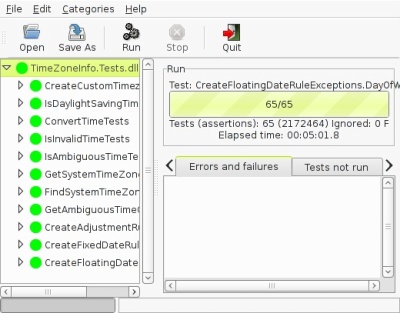 A few months ago, Stephane
Delcroix was working on F-Spot and he needed to track
time zone information for pictures.
A few months ago, Stephane
Delcroix was working on F-Spot and he needed to track
time zone information for pictures.
The .NET framework did not offer anything to make this easy. Only one timezone could be constructed: the system one.
His original plan was to implement Mono.ExtendedTimeZone that would be a derived class from the TimeZone class in the framework but that would be populated from some other database.
He considered a few choices and discussed:
- Use libc in some form, to pull the data out of it (external program) and create the instances of the timezone as needed. This could be slow due to using an external program with a temporary TZ setting.
- Parse the libc datafiles, very OS/distribution-specific.
- Ship our own databases.
We did not want to go into the business of maintaining the timezone files and redistribute Mono updates every time new countries were created or rules changed, so we opted for dumping the data out of libc in some form.
Stephane ended up parsing the GNU libc datafiles: they did not depend on external programs, works on Linux easily and is fast. This will require the code to be ported to other platforms though.
Around that time we discovered that Orcas (.NET 3.5) included a class to cope with this problem in the form of System.TimeZoneInfo in the System.Core.dll assembly. So his API effort changed from implementing a Mono.ExtendedTimeZone to implement System.TimeZoneInfo. Yesterday he emailed me the above screenshot and we got the code commited to SVN.
Check Stephane's PicasaWeb album it contains various screenshots of his F-Spot work.
Posted on 12 May 2007
C# 3.0 updates
Scott Peterson blogs about his recent contributions to the C# 3.0 compiler:
Variable type inference (the "var" keyword) Anonymous types. Implicitly typed arrays. Object initialization. Collection initialization.
Scott is participating in the Google Summer of Code. His summer project is to port the Banshee Media Player to Windows. But I guess he had to have those 3.0 features before he could start. It makes perfect sense. This patch was reviewed and mentored by Marek Safar who has been implementing various other parts of the C# 3 support (extension methods, the new LINQ parser and the updated delegate semantics).
The new object initialization allows properties to be set at construction time, for example:
// C# 2 style
Gtk.Window w = new Gtk.Window ();
w.Title = "My App";
w.Visible = true;
// C# 3 style
Gtk.Window w = new Gtk.Window () { Title = "My App", Visible = true };
This also works for events:
Gtk.Button b = new Gtk.Button ("Ok") { Clicked = ok_clicked };
Or using the new lambda expressions:
Gtk.Button b = new Gtk.Button ("Ok") {
Visible = true,
Clicked = (sender,args) => { Console.WriteLine ("Clicked"); }
};
The last case (delegate) is currently not supported by mcs.
Posted on 09 May 2007
Dynamic Language Runtime
The presentation by Jim Hugunin and John Lam on the Dynamic Language Runtime (DLR) was a great introduction for the general public on what they are trying to do.
They showed their Ruby compiler consuming JavaScript and
Visual Basic code from a single program:
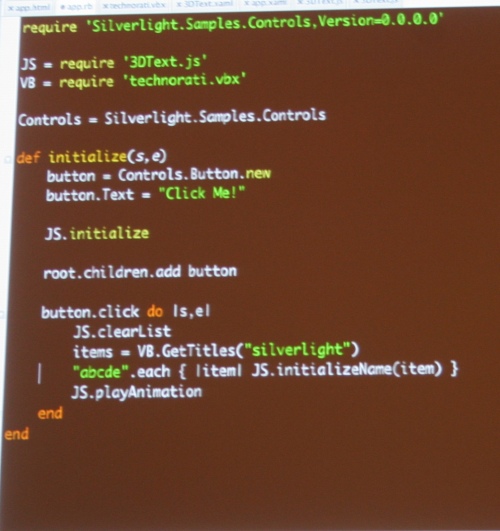 In the above example, Ruby has been extended to allow
importing modules, for instance
In the above example, Ruby has been extended to allow
importing modules, for instance
JS = require '3DText.js'
Imports the code that does 3D transformations (written in Javascript) into the constant JS. To access functions in that javascript module, you just prefix the call with JS, like show on the screenshot (JS.playAnimation for example).
The Dynamic Language Runtime augments the Common Language Runtime and is made up of a few chunks:
- A shared type system for dynamic languages.
- A shared AST that can be used by language developers to create new dynamic languages.
- Helper/utility routines for compiler developers.
- A common hosting interface, to embed the general purpose scripting language interface into your program, and allowing developers to extend applications with one or more dynamic languages.
- Console support, they even have a simple console interface for doing interactive programming.
Today Jim has a post describing in more detail the shared type system:
They demonstrated the DLR Console, a sample application written in IronPython that allows developers to interactively write and test their code for Silverlight.
You can watch the presentation here.
Variables and functions declared in one language are automatically visible to the other languages, and by clicking on the language at the bottom of the screen programmers can switch between languages on the same session.
My photo did not come out very clear, but in this shot you
can see vb, javascript and ruby. The popit routine written
in VB, the event wired up in Javascript, and another event
wired up in Ruby:
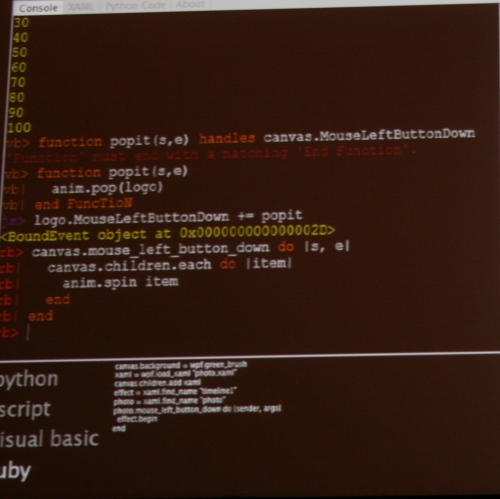 An interesting feature of the DLR is that they added a
mapping system for function names, so that code does not feel
alien in other programming languages.
An interesting feature of the DLR is that they added a
mapping system for function names, so that code does not feel
alien in other programming languages.
So the event MouseLeftButtonDown from the CLR is exposed to
NRuby as mouse_left_button_down in Ruby, here you can see
auto-complete when running under the Ruby context:
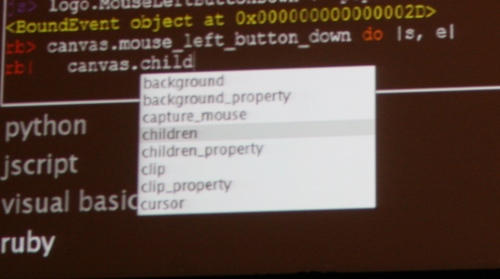 Those properties in .NET are capitalized.
Those properties in .NET are capitalized.
Various technical details appear on this interview by Darryl Taft:
Hugunin: In many ways, all the DLR does is it takes these things that we did custom for IronPython and it makes them work for a broad spectrum of languages. So instead of having a Python type system we now have a dynamic type system. So any language that has dynamic operations can share them
The DLR and Mono
As usual, Hugunin's team keeps exposing bugs in our compiler. For example, we did not notice when C# 2.0 came out that the operator declaration grammar now allowed for attributes on operator parameters:
operator-declaration:attributesopt operator-modifiers operator-declarator operator-body
That one is fixed on SVN, but am not sure its worth backporting to the 1.2.4 branch. Another issue seems to be a case of not implementing fully method group conversions as the code seems to be comparing a delegate variable against a method and we barf on that one. A simple fix for now is to merely do a manual conversion in the source "new DelegateType (Method)".
I did not research this one yet, but plan on doing that today.
The final issue seems to be an issue with the operator priorities, our compiler does not like expressions like this:
type t = var as TypeName ?? dingus;
A temporary fix for now is to put parenthesis around "var as TypeName". It should be an easy fix
With those fixes you can get the DLR building on Mono, I have not tried the rest of IronPython as am just freshly unpacked from Vegas.
JavaScript
Deepak Jain pointed out by email that the Javascript support in the DLR is their new engine, and not a research prototype.
This new Javascript implementation is following the steps of IronPython: to be true to the original language without .NET extensions. So this is different than JScript.NET that added a bunch of extensions to be a CLR citizen.
Their new ECMAscript implementation is more of a DLR citizen and true in spirit of it.
Ruby, Python and the DLR are released under the MsPl, and it would be great if they also did this for Javascript.
Posted on 03 May 2007
Digger on Silverlight
So we have all seen the spinning text, the video puzzles and the rotating spiderman trailer.
But real programs are more complicated than those simple demos. Lutz Roeder has a page with Silverlight applications that he has written.
My favorite: his Windows.Forms digger port. You can see it here or you can download the sources and learn for yourself here.
Posted on 03 May 2007
Mike Krueger Joins the Mono Team
Mike Krueger, the creator of the Sharp Develop IDE, has joined Novell.
Mike will be working with Ankit, Lluis and Jeff to improve the MonoDevelop IDE, and to try to share more code between SharpDevelop and MonoDevelop.
Posted on 03 May 2007
Mix 07, Silverlight, Dynamic Languages Runtime and OpenSource
A very impressive set of demos at Mix 07, the 72 hour conversation that Microsoft is having in las Vegas.
The focus was mostly around Silverlight, Microsoft's new web plugin to author rich application and tools used to design this content.
The whole Expression suite was adorable, and Blend is fantastic.
The demos were pretty amazing, Scott built a nice animation for an airline reservation system on stage:
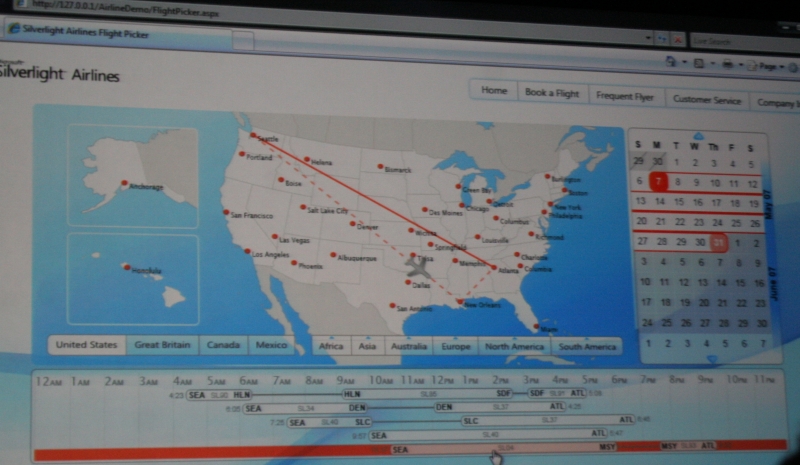
Silverlight and WPF
Today Microsoft announced two Silverlight editions: one that went into beta (Silverlight 1.0) and is a relatively simple technology.
Silverlight 1.0 uses a retained graphics system (a canvas) that exposes the internal structure to the browser DOM. It has no scripting capabilities built into it, all the scripting support is actually done by the Javascript interpreter in the browser and all changes are done by talking to a Javascript object exposed by the hosted Silverlight surface.
The scene definition is done using the XAML markup using a subset of the WPF primitives available in the full-blown WPF. Then the big announcement came:
The second edition was Silverlight 1.1, and this one is a different beast altogether. 1.1 extends the model by embedding a complete Common Language Runtime. Here is the slide that Scott used for this part of the presentation:
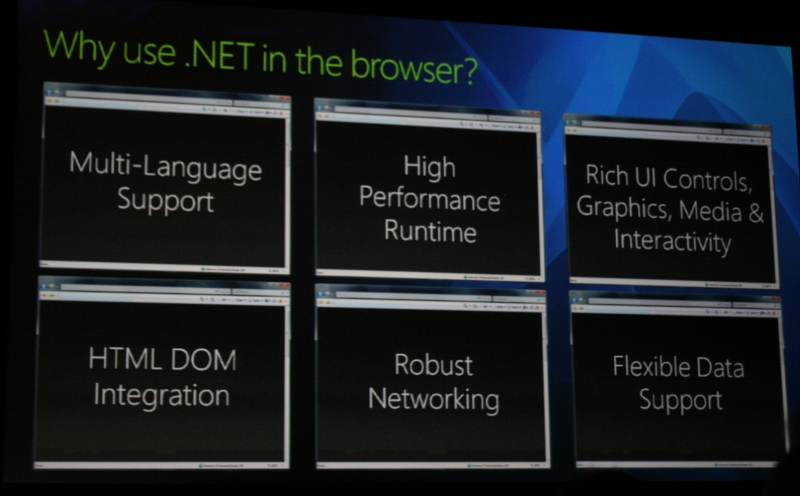
Scott did a demo of a chess program that had logic built with JavaScript and C#, notice the nodes per second computation:
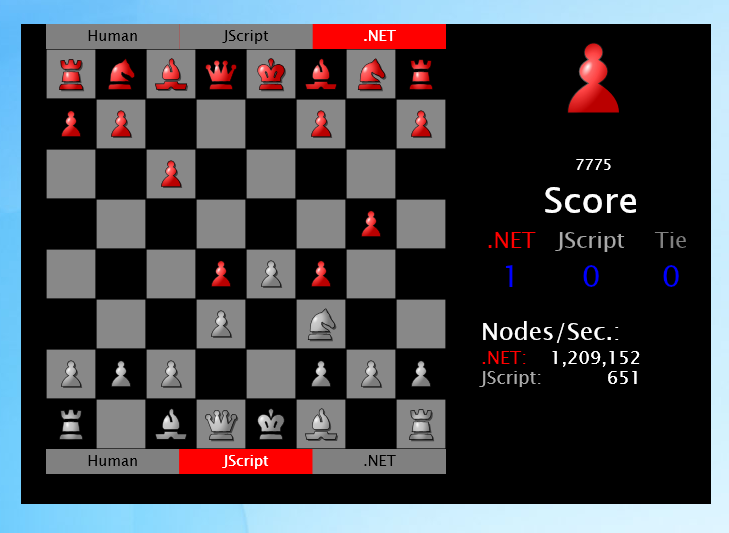
The outcome of the famous battle between dog vs vampire:
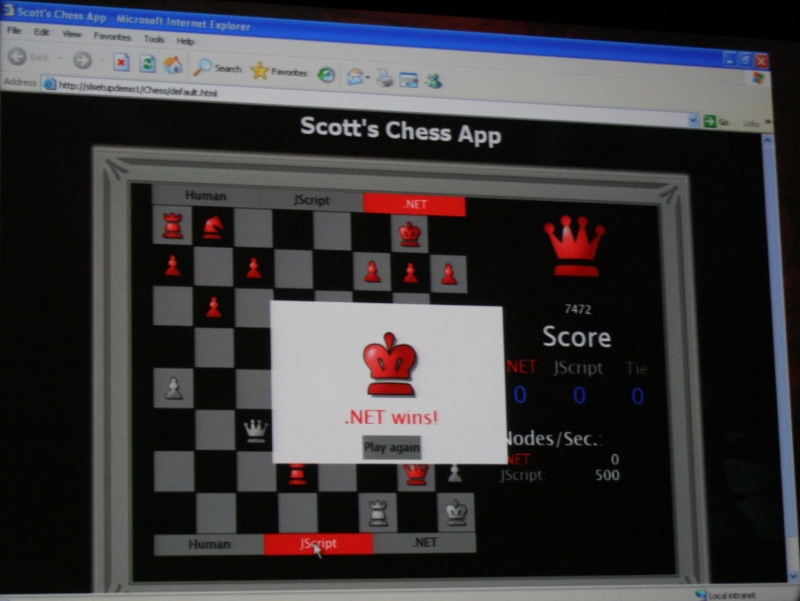
There are a handful of changes to the runtime. Here are some notes on what I found out about it today. It might not be complete nor accurate:
- A new security system: Unlike the CAS there is no stalk walking but instead there are trusted and untrusted assemblies. This is part of a new sandboxing model.
- Trusted assemblies have a way of flagging entry
points as being untrusted. which requires that the
caller be a trusted assembly.
This means that calling things like FileStream File.Open (string filename) from an untrusted assembly is not permitted.
Instead developers would call something like FileStream File.OpenDialog(...) (which is hosted in a trusted assembly) and this would in turn call File.Open(string) and this would return a FileStream that the user selected with a dialog box.
- The API has been trimmed down: some classes were removed that did not make much sense for the core.
- A Minimalist WPF implementation: this is
now available as a new assembly. This implementation
at this point does not seem to have support for
high-level controls like Buttons or Sliders, those
have to be authored in a per-application basis.
There is talk about which pieces belong in the minimal WPF and which pieces do not.
In my opinion, keeping the controls out was a good idea as the controls in the real WPF are a bit too big.
- Dynamic Language Runtime: the dynamic language runtime is an integral part of the Silverlight distribution.
Dynamic Language Runtime
The Dynamic Language Runtime was announced today. Jim Hugunin's blog has the details and rumor is that in the next couple of days/weeks he will be posting on his blogs the technical details behind the design of the DLR.
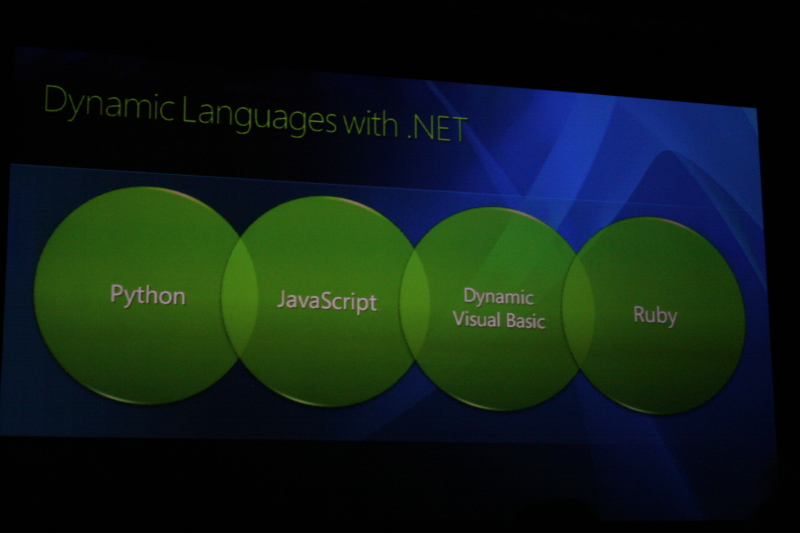
Binaries of the DLR were released today as part of Silverlight 1.1, and the source code was included with IronPython 2.0 (also released today).
The release for the DLR is done under the terms of the Microsoft Permissive License (MsPL) which is by all means an open source license. This means that we can use and distribute the DLR as part of Mono without having to build it from scratch. A brilliant move by Microsoft.
During the keynote they announced support for four dynamic languages built on top of the DLR: Python, JavaScript (ECMAScript 3.0), Visual Basic and Ruby.
The rumor on the halls is that IronPython and Ruby will be released under the MsPL license, while ECMAscript and Visual Basic will continue to be proprietary. From Jim's announcement:
For the short term, our focus is on using a small number of languages to drive the first wave of DLR development where we can work closely and face-to-face with the developers in order to iron out the worst kinks in the DLR design. After this initial phase, we want to reach out to the broader language community. If you're building a language on top of .NET and are interested in supporting dynamic language features then we want your feedback on the DLR. However, I'd discourage you from trying to implement on top of the DLR today. I don't want you to get frustrated trying to work with these really early bits and then not be interested in working with us when we're better prepared to engage with the language community. We plan to kick off a broader engagement with language implementers at the upcoming lang.net conference in three months - at the end of July. This will be the best place to really engage with the DLR and let us know what we got wrong.
Mono and Silverlight
For a long time a common question to the Mono team was when we were planning on implementing WPF.
Most people want to hear a date like "tomorrow", "next month", "in a year". But the answer is more complex than just thinking "we can do this in N months".
We as a team have to evaluate the cost of implementing a technology and contrast it with the impact that such technology would have. With our finite development resources (in the Mono community and the companies contributing to it) we have to pick our battles.
And implementing WPF was never really high up on the priority list for a couple of reasons:
- WPF requires a very big investment before things will start working.
- Users of WPF is limited to those starting new applications and are willing to start those applications using WPF.
- Only a minority of existing users (Windows.Forms) were willing to rewrite their software to move it to WPF. The rest basically will continue developing Windows.Forms and using the technologies they have been using for the time being.
So it is fair to say that we currently do not have plans to look at WPF.
But a Mono-based Silverlight is an entirely different story. Unlike WPF that requires people to rewrite their software to take advantage of it, Silverlight is aimed at the Web and it will become a nice complement, a way of spicing up existing web applications without rewriting what already works.
It makes tons of sense for us to start looking at an implementation of Silverlight on Linux with Mono. There is already a XAML loader, it is the perfect excuse to use Antigrain for high-speed graphics and that only leaves the pesky media issue to be solved.
In fact, am kind of happy that Microsoft did not do the port themselves as implementing this sounds incredibly fun and interesting.
Upsides
The major upside of this show has been how open the Microsoft folks have been open to discuss technicalities of any sorts.
I had the chance of participating on an open source panel at the conference and PHP, Mozilla, SubSonic.NET and Mono were well represented and I did not fell any angry mood from anyone.
There is also a surprising amount of talk about using the MsPL license, again, all good news.
Finally, I also made tons of new friends, have had a great time with everyone I have met here. I also noticed that both Jon Udell and Dave Winer both look happier, they were always smiling,
IE 8?
Someone mentioned (and I forget whom it was) that talk about IE8 was strangely missing from the whole conversation. There were no announcements about new upcoming features in IE, no mention of whether IE8 will support what-wg nor any future plans.
Predictions
So how did my predictions score?
- "They will spend most of the time showing the new features in the recently released Orcas and probably the Silverlight media encoder." At least on the keynote there were little demos of Orcas, most of the demos were demos about Expression, but they did show the Silverlight media encoder. Am going to give myself half a point.
- "There will be a fresh Silverlight update." score 1.
- "Blend and Expression Design will probably ship as a final product, or a new beta will be released." They did. score 1.
- "Dynamic Language Runtime: a set of class libraries with some sort of supporting infrastructure in the CLR to help dynamic language authors speed up their code.". score 1.
- "Javascript: probably Microsoft will announce that they are upgrading the JScript compiler in .NET." Although they did announce that it would be writing a new JavaScript compiler, it is not clear if its a research prototype to test the DLR or the real thing, so am going to go with half a point.
- "Silverlight will bundle a micro-clr." Silverlight bundled a full CLR. So zero points, although I was close.
- "Silverlight for Linux. And if there is no announcement, we should try to get someone drunk enough to get them to do it." There was no announcement of Silverlight for Linux, but I was still kind of joking. But I did get drunk with senior Microsoft employees. One point.
So 5 point out of 7, not bad.
Update: Deepak Jain points out that the new Javascript implementation is not a research prototype, but their new Javascript implementation. The real thing.
Which gives me full point, so 5.5 out of 7, I think I fared better than most analysts and pundits. I should become an analyst at RedMonk in my next life.
Posted on 01 May 2007
Right-sizing the API
Jason Zander's blog entry on the Silverlight announcement contains a very important information nugget:
2. The APIs we are releasing are "right sized". That means we looked for the most powerful subset we could find while keeping the size small.
This I think is what makes Silverlight so interesting to me. Compared to WPF which is a complete framework for desktop applications, they are doing an effort to keep the APIs to a minimum.
Default Widgets: Silverlight comes with no pre-defined widgets, and although at first this seems like a weakness, during one of the presentations today it was clear that one-size-fits-all was not going to give everyone what they wanted.
I believe it was during Mike Harsh presentation, where he created a nice looking custom button out of simple primitives.
Posted on 01 May 2007
« Newer entries | Older entries »
Blog Search
Archive
- 2024
Apr Jun - 2020
Mar Aug Sep - 2018
Jan Feb Apr May Dec - 2016
Jan Feb Jul Sep - 2014
Jan Apr May Jul Aug Sep Oct Nov Dec - 2012
Feb Mar Apr Aug Sep Oct Nov - 2010
Jan Feb Mar Apr May Jun Jul Aug Sep Oct Nov Dec - 2008
Jan Feb Mar Apr May Jun Jul Aug Sep Oct Nov Dec - 2006
Jan Feb Mar Apr May Jun Jul Aug Sep Oct Nov Dec - 2004
Jan Feb Mar Apr May Jun Jul Aug Sep Oct Nov Dec - 2002
Jan Feb Mar Apr May Jun Jul Aug Sep Oct Dec
- 2022
Apr - 2019
Mar Apr - 2017
Jan Nov Dec - 2015
Jan Jul Aug Sep Oct Dec - 2013
Feb Mar Apr Jun Aug Oct - 2011
Jan Feb Mar Apr May Jun Jul Aug Sep Oct Nov Dec - 2009
Jan Feb Mar Apr May Jun Jul Aug Sep Oct Nov Dec - 2007
Jan Feb Mar Apr May Jun Jul Aug Sep Oct Nov Dec - 2005
Jan Feb Mar Apr May Jun Jul Aug Sep Oct Nov Dec - 2003
Jan Feb Mar Apr Jun Jul Aug Sep Oct Nov Dec - 2001
Apr May Jun Jul Aug Sep Oct Nov Dec